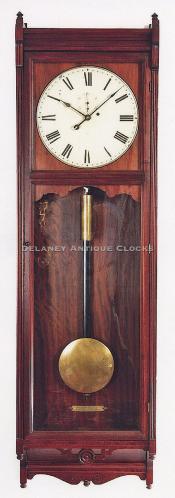Seth Thomas Clock Company. The wall Regulator No. 17 in mahogany. 214044.
This is a large wall clock. The case measures approximately 68 inches long. It is 19 inches wide and 7.25 inches deep. The large glass panel in the lower section of the door provides a fantastic opportunity to advertise one’s business. Clocks like this make excellent icebreakers in an office or work setting. Incoming customers or clients find it easy to start conversations when they can comment on items like this.
This fine example features a case that is constructed in mahogany, and it retains its original finish. This finish is clean and consistent. The large painted zinc dial measures 14 inches in diameter and is original to this clock. The paint remains in very good condition. The dial is decorated with large Roman hour numerals, a subsidiary seconds dial, and the Maker’s trademark. The movement is mounted to an iron bracket to the back of the case. This No. 62 movement design is constructed in brass. The plates are keystone-shaped. The front plate is die-stamped with the Maker’s trademark. Both plates support the steel shafts and cut pinions. The shafts are fitted with brass gearing, which includes maintaining power and a Graham Deadbeat escapement. This clock beats seconds. It is weight-powered and is designed to run for eight days on a full wind. The pendulum is constructed with a wooden rod that supports a zinc bob covered in brass. This is designed to compensate for temperature changes. The weight is also brass-covered and matches the coloring of the bob. It hangs from the original brass pulley. Note this clock retains its swing indicator, which is mounted to the backboard of the case.
This attractive clock was made circa 1900. It is an excellent example.
Inventory number 214044.
Seth Thomas was born in Wolcott, Connecticut, in 1785. He was apprenticed as a carpenter and joiner and worked building houses and barns. He started in the clock business in 1807, working for clockmaker Eli Terry. Thomas formed a clock-making partnership in Plymouth, Connecticut, with Eli Terry and Silas Hoadley as Terry, Thomas & Hoadley. In 1810, he bought Terry's clock business, making tall clocks with wooden movements. Seth chose to sell his shares in the partnership in 1812, moving in 1813 to Plymouth Hollow, Connecticut, where he set up a factory to make metal-movement clocks. In 1817, he added shelf and mantel clocks. By the mid-1840s, He successfully transitioned to brass movements and expanded his operations by building a brass rolling mill and a cotton factory. In 1853, He incorporated the business but continued to be the majority shareholder. This clock business expanded until it became one of the "BIG Seven" in Connecticut. Their product line had offerings that competed at every price point, from kitchen clocks to precision regulators. Seth Thomas died in 1859. The community of Plymouth Hollow so revered him that they changed the name on July 6, 1875, to Thomaston in his honor. After his death, his son, Aaron, took over the company's leadership. Aaron is credited with increasing the business by adding a number of new case styles and improving production methods. The company went out of business in the 1980s.










